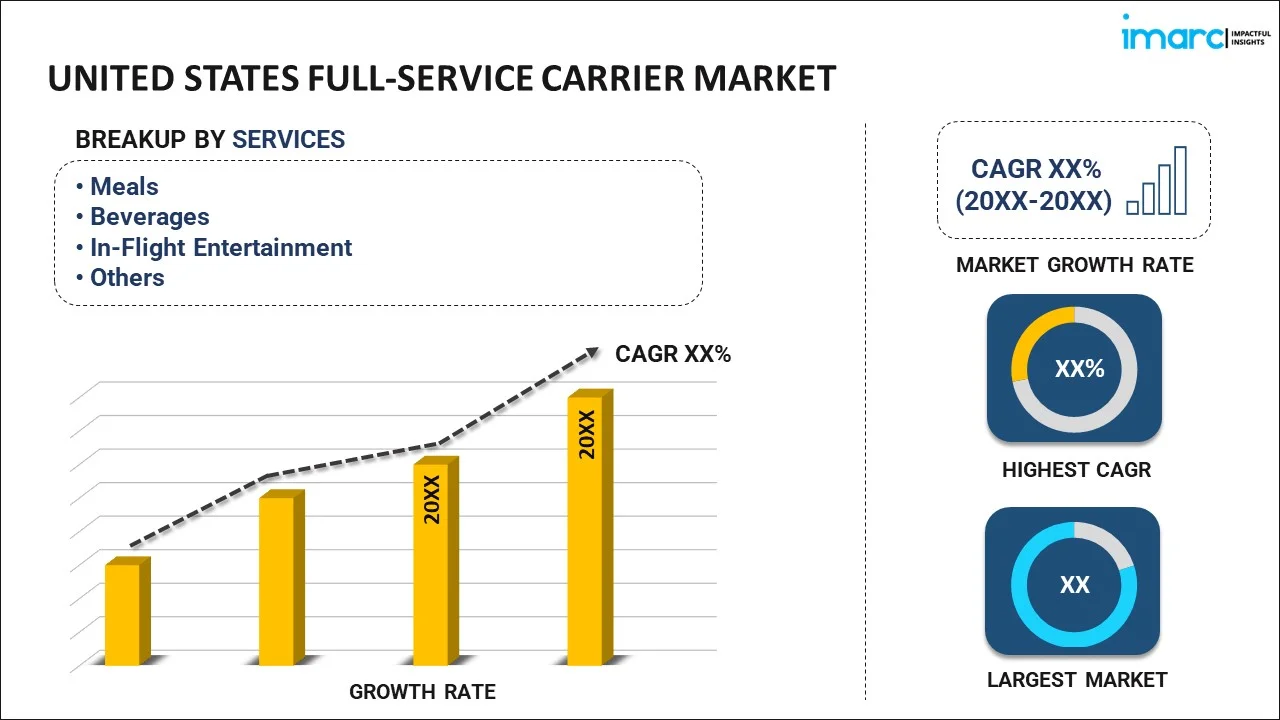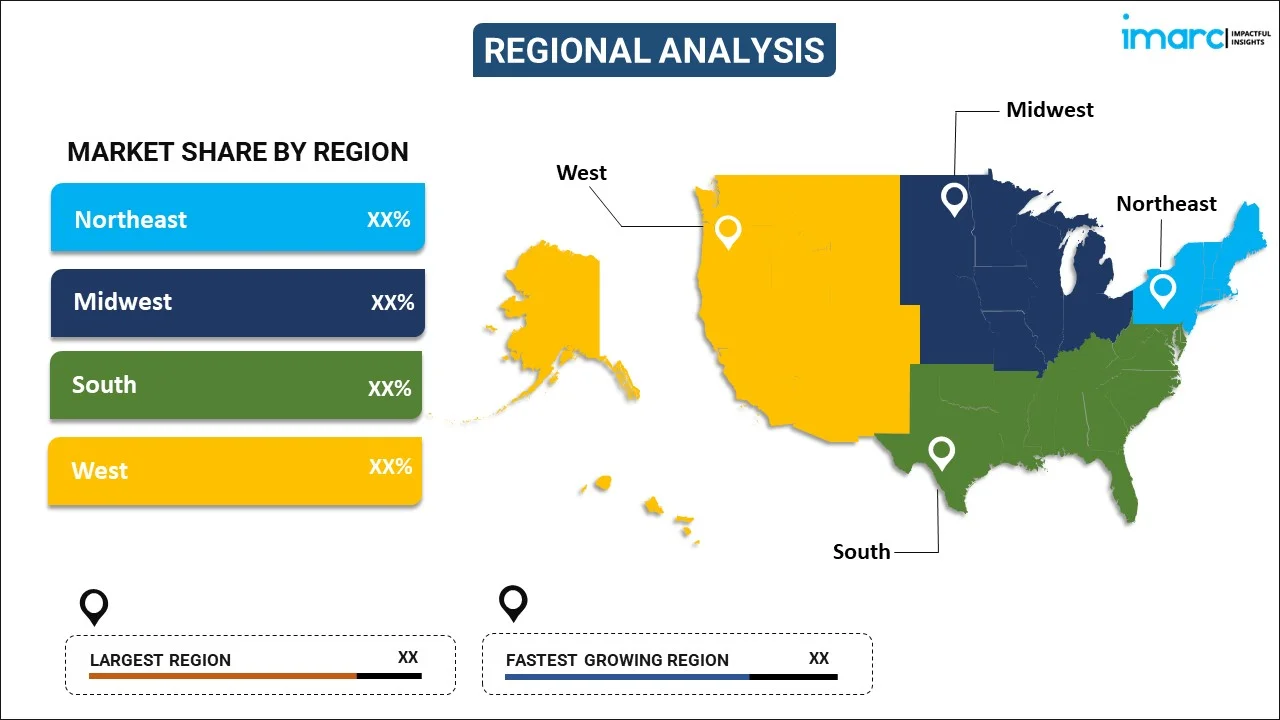
United States Full-Service Carrier Market Report by Service (Meals, Beverages, In-Flight Entertainment, and Others), Application (International Aviation, Domestic Aviation), and Region 2025-2033
Market Overview:
United States full-service carrier market size is projected to exhibit a growth rate (CAGR) of 4.95% during 2025-2033. The increasing demand for business travel, which often involves premium services offered by full-service carriers, is driving the market.
|
Report Attribute
|
Key Statistics
|
|---|---|
|
Base Year
|
2024 |
|
Forecast Years
|
2025-2033 |
|
Historical Years
|
2019-2024
|
| Market Growth Rate (2025-2033) | 4.95% |
A full-service carrier refers to an airline that offers a comprehensive range of services to passengers, typically including amenities such as in-flight meals, entertainment, checked baggage, and various seating options. These carriers are known for providing a higher level of service compared to low-cost or budget airlines. Full-service carriers often operate on longer-haul routes and cater to a diverse clientele, including business and leisure travelers. They maintain a more extensive network of destinations, with a focus on major domestic routes. The ticket prices of full-service carriers generally include various amenities, and passengers have the option to choose from different classes of service, such as economy, business, and first class. The emphasis on comfort, convenience, and a broader range of services distinguishes full-service carriers from their more no-frills counterparts in the airline industry.
United States Full-Service Carrier Market Trends:
The full-service carrier sector in the United States is experiencing significant market drivers that propel its growth and competitiveness. Firstly, the expanding regional economy has led to an increase in business and leisure travel, driving demand for comprehensive services provided by full-service carriers. Moreover, the rise of disposable income among the middle class has contributed to a surge in air travel, further benefiting full-service carriers. In addition to economic factors, technological advancements have played a crucial role in shaping the landscape of the full-service carrier market. The adoption of innovative aircraft, state-of-the-art reservation systems, and enhanced in-flight entertainment options has attracted passengers seeking a seamless and comfortable travel experience. Furthermore, strategic alliances and code-sharing agreements between full-service carriers have become prominent, creating extensive networks and providing customers with a wider range of destinations. Government policies and regulations also act as significant drivers for the full-service carrier market. Besides this, as the aviation industry continues to evolve, full-service carriers are adapting to these multifaceted drivers, positioning themselves to meet the evolving needs and preferences of the modern traveler.
United States Full-Service Carrier Market Segmentation:
IMARC Group provides an analysis of the key trends in each segment of the market, along with forecasts at the country level for 2025-2033. Our report has categorized the market based on service and application.
Service Insights:

- Meals
- Beverages
- In-Flight Entertainment
- Others
The report has provided a detailed breakup and analysis of the market based on the service. This includes meals, beverages, in-flight entertainment, and others.
Application Insights:
- International Aviation
- Domestic Aviation
A detailed breakup and analysis of the market based on the application have also been provided in the report. This includes international aviation and domestic aviation.
Regional Insights:

- Northeast
- Midwest
- South
- West
The report has also provided a comprehensive analysis of all the major regional markets, which include Northeast, Midwest, South, and West.
Competitive Landscape:
The market research report has also provided a comprehensive analysis of the competitive landscape. Competitive analysis such as market structure, key player positioning, top winning strategies, competitive dashboard, and company evaluation quadrant has been covered in the report. Also, detailed profiles of all major companies have been provided.
United States Full-Service Carrier Market Report Coverage:
| Report Features | Details |
|---|---|
| Base Year of the Analysis | 2024 |
| Historical Period | 2019-2024 |
| Forecast Period | 2025-2033 |
| Units | Million USD |
| Scope of the Report | Exploration of Historical Trends and Market Outlook, Industry Catalysts and Challenges, Segment-Wise Historical and Future Market Assessment:
|
| Services Covered | Meals, Beverages, In-Flight Entertainment, Others |
| Applications Covered | International Aviation, Domestic Aviation |
| Regions Covered | Northeast, Midwest, South, West |
| Customization Scope | 10% Free Customization |
| Post-Sale Analyst Support | 10-12 Weeks |
| Delivery Format | PDF and Excel through Email (We can also provide the editable version of the report in PPT/Word format on special request) |
Key Questions Answered in This Report:
- How has the United States full-service carrier market performed so far and how will it perform in the coming years?
- What has been the impact of COVID-19 on the United States full-service carrier market?
- What is the breakup of the United States full-service carrier market on the basis of service?
- What is the breakup of the United States full-service carrier market on the basis of application?
- What are the various stages in the value chain of the United States full-service carrier market?
- What are the key driving factors and challenges in the United States full-service carrier?
- What is the structure of the United States full-service carrier market and who are the key players?
- What is the degree of competition in the United States full-service carrier market?
Key Benefits for Stakeholders:
- IMARC’s industry report offers a comprehensive quantitative analysis of various market segments, historical and current market trends, market forecasts, and dynamics of the United States full-service carrier market from 2019-2033.
- The research report provides the latest information on the market drivers, challenges, and opportunities in the United States full-service carrier market.
- Porter's five forces analysis assist stakeholders in assessing the impact of new entrants, competitive rivalry, supplier power, buyer power, and the threat of substitution. It helps stakeholders to analyze the level of competition within the United States full-service carrier industry and its attractiveness.
- Competitive landscape allows stakeholders to understand their competitive environment and provides an insight into the current positions of key players in the market.
Need more help?
- Speak to our experienced analysts for insights on the current market scenarios.
- Include additional segments and countries to customize the report as per your requirement.
- Gain an unparalleled competitive advantage in your domain by understanding how to utilize the report and positively impacting your operations and revenue.
- For further assistance, please connect with our analysts.
 Inquire Before Buying
Inquire Before Buying
 Speak to an Analyst
Speak to an Analyst
 Request Brochure
Request Brochure
 Request Customization
Request Customization




.webp)




.webp)












